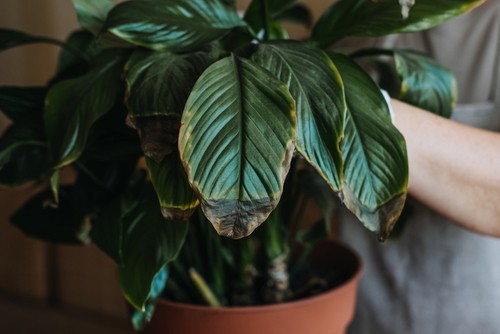Peace lilies are a popular indoor plant known for their beautiful white flowers and lush, green leaves. While they are relatively easy to care for, one common issue that many peace lily owners face is brown leaves. This can be a frustrating problem, especially if you’re not sure what’s causing it or how to fix it.
Brown leaves on peace lilies can be caused by a variety of factors, including overwatering, underwatering, poor lighting, and pest infestations. It’s important to understand the care requirements of peace lilies in order to keep them healthy and prevent brown leaves from developing.
In this article, we’ll explore the common problems associated with peace lilies and discuss how to address brown leaves when they occur.
Key Takeaways on Peace Lily Leaves Turning Brown
- Brown leaves on peace lilies can be caused by a variety of factors, including overwatering, underwatering, poor lighting, and pest infestations.
- Proper care and maintenance of peace lilies is essential for preventing brown leaves from developing.
- When brown leaves do occur, it’s important to identify the underlying cause and address it in order to restore the plant’s health.
Learn how to properly maintain your plant here:
Understanding Peace Lilies
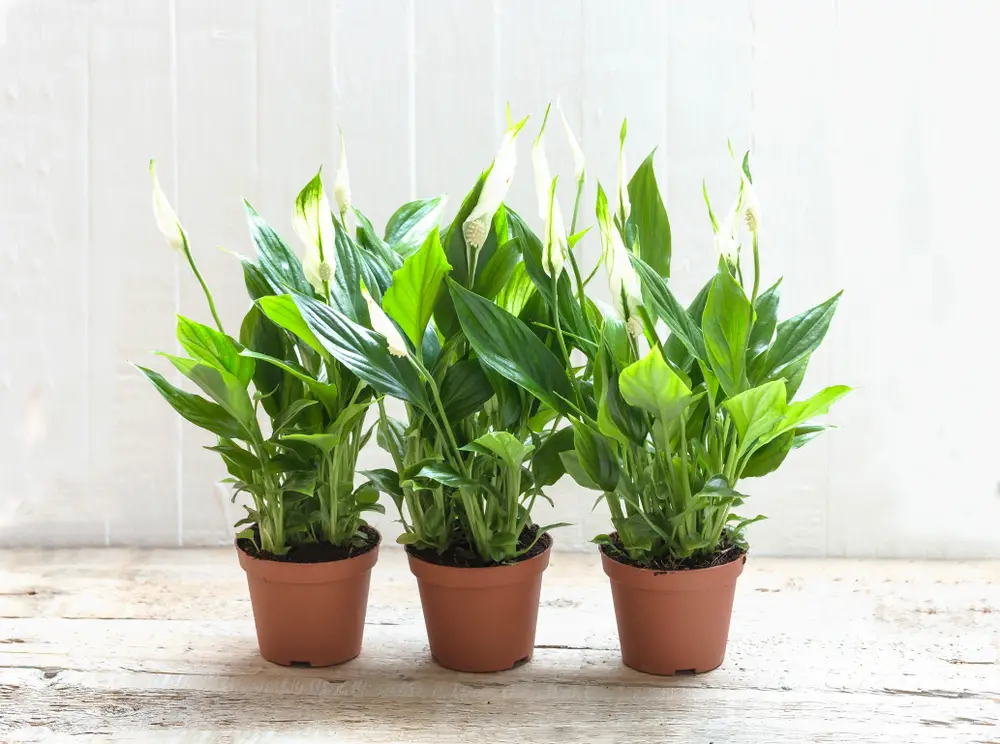
Peace lilies, also known as Spathiphyllum, are tropical plants that are native to the rainforests of South and Central America. They are a popular houseplant due to their beautiful white flowers and ease of care. However, one common issue that peace lily owners may face is the browning of their plant’s white leaves.
Peace lilies are known for their lush, green foliage and striking white flowers. They are a low-maintenance plant that thrives in low to medium light conditions and prefers consistently moist soil. While they are generally hardy, peace lilies can be susceptible to a number of issues that can cause their leaves to turn brown.
One of the most common reasons for brown leaves on peace lilies is overwatering. Peace lilies do not like to sit in water, and if their soil is kept too wet, their roots can become waterlogged and begin to rot.
This can cause the leaves to turn brown and wilted. On the other hand, if a peace lily is not watered enough, its leaves may also turn brown and dry out.
Another common cause of brown leaves on peace lilies is exposure to direct sunlight. While peace lilies can tolerate low to medium light conditions, they should not be placed in direct sunlight. Direct sunlight can cause the leaves to burn and turn brown.
In addition to these issues, peace lilies may also experience brown leaves due to pests, disease, or improper fertilization. It is important to regularly inspect a peace lily for signs of pests or disease, and to fertilize it according to its specific needs.
Peace Lily Care Requirements
Peace lilies are popular indoor plants due to their attractive foliage and ease of care. They are native to the tropical regions of Central and South America and thrive in warm, humid environments. Here are some care requirements to keep in mind when caring for your peace lily:
1. Humidity
Peace lilies prefer a humid environment, so it’s important to keep the air around them moist. You can achieve this by placing a humidifier near the plant or by placing a tray of water near the plant. Alternatively, you can mist the leaves regularly with water.
2. Temperature
Peace lilies prefer temperatures between 65-80°F (18-27°C). They can tolerate temperatures outside of this range, but extreme temperatures can cause damage to the plant.
3. Indirect Light
Peace lilies prefer bright, indirect light. Direct sunlight can scorch the leaves, so it’s best to place them in a spot where they can receive bright, filtered light.
4. Water
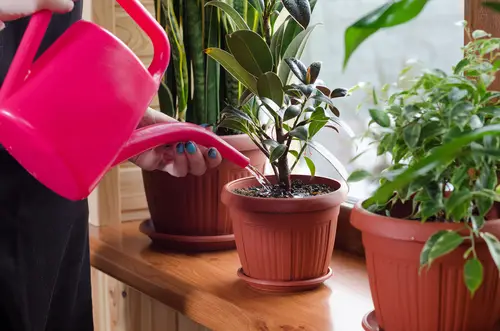
Peace lilies prefer to be kept consistently moist, but not waterlogged. It’s important to ensure that the soil is well-draining and that the plant is not sitting in standing water. Bottom watering can be an effective way to ensure that the plant is getting enough water without overwatering.
5. Fertilizer
Peace lilies benefit from regular fertilization during the growing season (spring and summer). A balanced, water-soluble fertilizer can be applied once a month.
6. Drainage
It’s important to ensure that the pot has adequate drainage to prevent water from accumulating in the soil. This can lead to root rot and other issues.
7. Environment
Peace lilies prefer a stable environment and can be sensitive to changes in temperature, humidity, and light. It’s best to avoid placing them near drafty windows or doors.
8. Watering Schedule
It’s important to establish a regular watering schedule for your peace lily. This will depend on factors such as the size of the pot, the humidity of the environment, and the time of year. As a general rule, peace lilies should be watered when the top inch of soil feels dry to the touch.
Peace Lily Leaves Turning Brown – 4 Common Problems
Peace lilies are a popular houseplant known for their beautiful white flowers and lush green leaves. However, like any other plant, peace lilies can experience problems that affect their appearance and health. Here are some common problems that peace lilies may encounter:
Brown Leaves and Brown Leaf Tips
Brown leaves and brown leaf tips are a common problem with peace lilies. This can be caused by a variety of factors, including overwatering, underwatering, too much direct sunlight, or exposure to cold drafts.
To fix this problem, it is important to identify the underlying cause and adjust the plant’s care accordingly. For example, if the plant is overwatered, it may be necessary to reduce the frequency of watering or adjust the soil drainage.
Wilting and Drooping Leaves
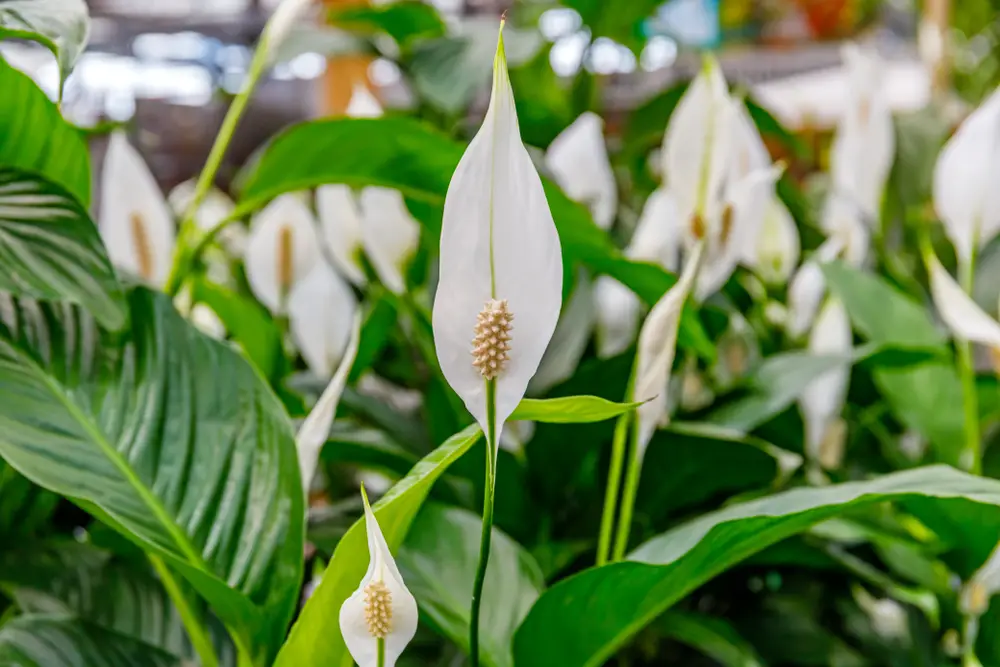
Wilting and drooping leaves are another common problem with peace lilies. This can be caused by underwatering, overwatering, or exposure to extreme temperatures. To fix this problem, it is important to adjust the plant’s care to ensure that it is receiving the right amount of water and is not exposed to extreme temperatures.
Yellow Leaves
Yellow leaves are a sign of stress in peace lilies. This can be caused by a variety of factors, including overwatering, underwatering, exposure to direct sunlight, or exposure to cold drafts. To fix this problem, it is important to identify the underlying cause and adjust the plant’s care accordingly.
Pest Infestation
Peace lilies can be susceptible to pest infestations, including aphids, spider mites, and mealybugs. These pests can cause damage to the plant’s leaves and flowers, and can also spread diseases and fungal growth.
To prevent pest infestations, it is important to keep the plant clean and free of debris, and to monitor the plant regularly for signs of infestation.
Overall, peace lilies are a relatively low-maintenance plant, but they can experience problems from time to time. By identifying and addressing these problems early on, it is possible to keep your peace lily healthy and thriving.
Factors Contributing to Brown Leaves
Peace lilies are a popular houseplant due to their beautiful white flowers and lush foliage. However, brown leaves can be a common issue for many peace lily owners. There are several factors that can contribute to this problem, including watering issues, light and temperature factors, and humidity and fertilizer.
1. Watering Issues
Watering issues are one of the most common causes of brown leaves in peace lilies. Underwatering and overwatering can both cause the leaves to turn brown.
When a peace lily is underwatered, the leaves will start to curl and turn brown at the tips. On the other hand, overwatering can lead to root rot, which can cause the entire plant to wilt and turn brown.
To avoid these issues, it’s important to water your peace lily properly. Peace lilies prefer to be kept consistently moist but not waterlogged. It’s important to allow the top inch of soil to dry out before watering again.
Additionally, make sure to use room temperature water that is free of minerals, as minerals can build up in the soil and cause brown leaves.
2. Light and Temperature Factors

Light and temperature factors can also contribute to brown leaves in peace lilies. Direct sunlight can scorch the leaves and cause them to turn brown, while too little light can cause the leaves to yellow and brown. Additionally, extreme temperatures can stress the plant and cause the leaves to brown.
It’s important to place your peace lily in a spot with bright, indirect light. Avoid placing it in direct sunlight or in a spot that is too dark. Additionally, make sure to keep the plant in a room with consistent temperatures between 65-80°F (18-27°C).
3. Humidity and Fertilizer
Humidity and fertilizer can also play a role in the health of your peace lily. Peace lilies prefer high humidity, and low humidity can cause the leaves to brown and curl. Additionally, overfertilizing or using too much fertilizer can cause the leaves to turn brown and even damage the roots.
To avoid these issues, make sure to keep the humidity around your peace lily high. You can do this by placing a tray of water near the plant or using a humidifier. Additionally, make sure to fertilize your peace lily only once a month during the growing season, and use a balanced, water-soluble fertilizer.
Addressing Brown Leaves on Peace Lilies
Peace lilies are popular indoor plants due to their ease of care and attractive foliage. However, brown leaves on peace lilies can be a common issue that can detract from their beauty. In this section, we will discuss various causes of brown leaves on peace lilies and how to address them.
Reviving Overwatered Peace Lilies
Overwatering is a common cause of brown leaves on peace lilies. When the soil is constantly wet, the roots can become waterlogged, leading to root rot. To revive an overwatered peace lily, the first step is to remove it from its pot and inspect the roots.
If they are brown and mushy, they may be suffering from root rot. In this case, the affected roots should be pruned, and the plant should be repotted in fresh soil with good drainage.
To prevent overwatering, peace lilies should be potted in containers with drainage holes, and the soil should be allowed to dry out slightly between waterings. Using a moisture meter can help determine when to water the plant.
Correcting Underwatering
Underwatering can also cause brown leaves on peace lilies. When the soil is too dry, the plant can become stressed, leading to brown leaves.
To correct underwatering, the plant should be watered thoroughly, and the soil should be kept consistently moist. Peace lilies prefer a well-draining soil mix that retains moisture but does not become waterlogged.
Adjusting Light and Temperature
Peace lilies prefer bright, indirect light, but too much direct sunlight can scorch their leaves, causing brown spots. On the other hand, too little light can cause the plant to become stressed, leading to brown leaves. Moving the plant to a location with appropriate lighting can help address this issue.
Peace lilies also prefer temperatures between 65-80°F (18-27°C). Temperatures outside of this range can cause stress and brown leaves. To maintain appropriate temperature, the plant should be kept away from drafts and air conditioning vents.
Managing Humidity and Fertilizer

Peace lilies prefer high humidity levels, and low humidity can cause brown leaves. To increase humidity, the plant can be misted regularly or placed on a tray of pebbles filled with water. Fertilizing the plant regularly with a balanced fertilizer can also help prevent brown leaves.
Preventive Measures for Healthy Peace Lilies
To keep peace lilies healthy and avoid white leaves turning brown, it is important to take preventive measures. Here are some tips to keep your peace lilies healthy:
1. Care
Peace lilies are easy to care for. They like bright, indirect light and moist soil. However, overwatering can be harmful to the plant, so make sure the soil is moist but not soggy. Fertilize the plant once a month during the growing season. Repotting the plant every two to three years will also help keep it healthy.
2. Water
Water is essential for the health of peace lilies, but using tap water can be harmful. Tap water contains chlorine, which can damage the plant’s roots. Using filtered water is a good option. Alternatively, leaving tap water in an open container for 24 hours before using it can help the chlorine evaporate.
3. Oxygen
Peace lilies need oxygen to survive. Overwatering the plant can cause the roots to suffocate, which can lead to brown leaves. Make sure the soil is well-draining to allow for proper oxygen flow to the roots.
4. Photosynthesis
Peace lilies need light for photosynthesis to occur. Bright, indirect light is ideal for the plant. However, too much direct sunlight can damage the leaves. If the leaves start to turn yellow, it may be a sign that the plant is getting too much light.
5. Misting
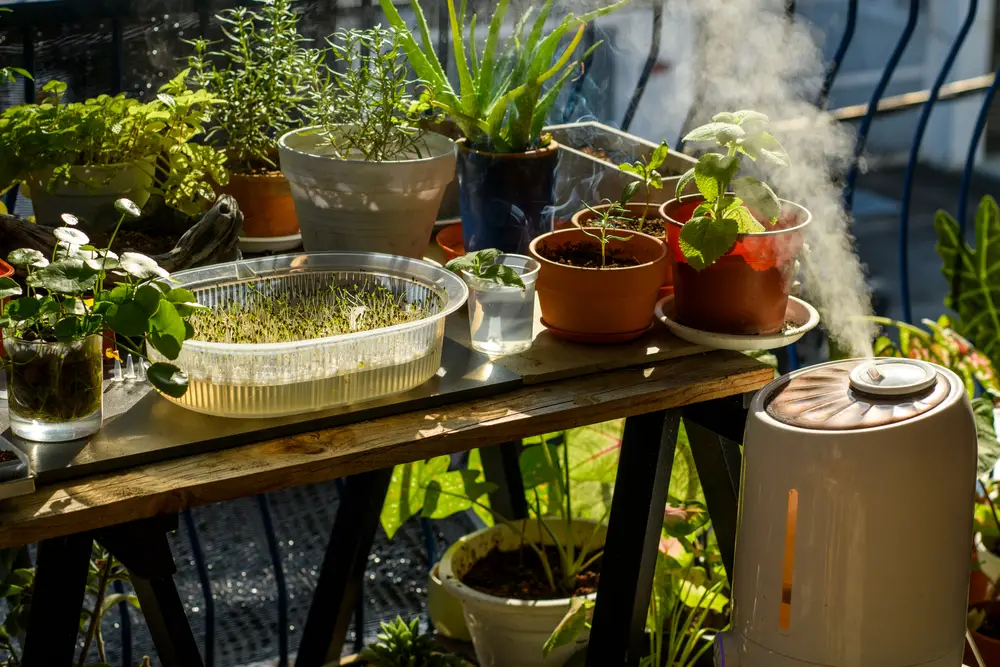
Misting the leaves of peace lilies can help increase humidity around the plant. This is especially important if the plant is in an air-conditioned room. However, misting should be done sparingly to avoid overwatering the plant.
6. Pot Size
Choosing the right pot size for peace lilies is important. The pot should be big enough to allow for proper root growth, but not too big that the soil stays wet for too long. A pot that is too small can also cause the soil to dry out too quickly.
Conclusion
There are several reasons why peace lily white leaves may turn brown. Overwatering, underwatering, moisture stress, and low humidity are some of the most common causes of peace lily leaves turning brown.
To prevent brown leaves, it is important to ensure that the peace lily is getting the right amount of water and humidity. It is recommended to water the peace lily when the top inch of soil is dry and to avoid overwatering. Additionally, placing a tray of water near the plant or using a humidifier can help to increase humidity levels.
It is also important to check for pests, as they can cause damage to the leaves. Spider mites, mealybugs, and scale insects are common pests that can infest peace lilies. Regularly inspecting the plant and treating any infestations promptly can help to prevent brown leaves.
Frequently Asked Questions
Why are my peace lily leaves turning brown at the tips?
Peace lily leaves turning brown at the tips is a common problem. There are several reasons why this may happen. One reason is that the plant is not receiving enough water. Peace lilies prefer to be kept in moist soil, so if the soil is too dry, the leaves will begin to turn brown at the tips.
Another reason could be that the plant is receiving too much direct sunlight. Peace lilies prefer indirect light, so if they are exposed to too much direct sunlight, their leaves can become damaged and turn brown at the tips.
How to treat brown tips on peace lily?
To treat brown tips on a peace lily, start by cutting off the brown tips with a pair of sharp scissors. Then, make sure the plant is receiving the proper amount of water.
Peace lilies prefer to be kept in moist soil, so make sure the soil is not too dry. Also, make sure the plant is not receiving too much direct sunlight, as this can cause the leaves to become damaged and turn brown.
Why is my peace lily flower turning brown?
Peace lily flowers turning brown is a natural process. The flowers will eventually die and turn brown as they age. However, if the flowers are turning brown prematurely, it could be a sign that the plant is not receiving enough water or is receiving too much direct sunlight.
Can you cut off brown peace lily flowers?
Yes, you can cut off brown peace lily flowers. This will help the plant conserve energy and focus on producing new growth. To cut off the flowers, use a pair of sharp scissors and cut the stem just above the base of the plant.
How to care for a peace lily indoors?
To care for a peace lily indoors, make sure the plant is kept in a location with indirect sunlight. Peace lilies prefer to be kept in moist soil, so make sure the soil is not too dry.
Water the plant when the soil feels dry to the touch, and make sure to drain any excess water from the saucer. Peace lilies also benefit from being fertilized once a month during the growing season.
Should I cut brown leaves off my peace lily?
Yes, you should cut brown leaves off your peace lily. This will help the plant conserve energy and focus on producing new growth. To cut off the leaves, use a pair of sharp scissors and cut the leaf just above the base of the plant.

Hey, I’m Lisa and I’ve been an avid gardener for over 30 years. I love writing, talking and living in the garden! Feel free to connect with me on my socials below

